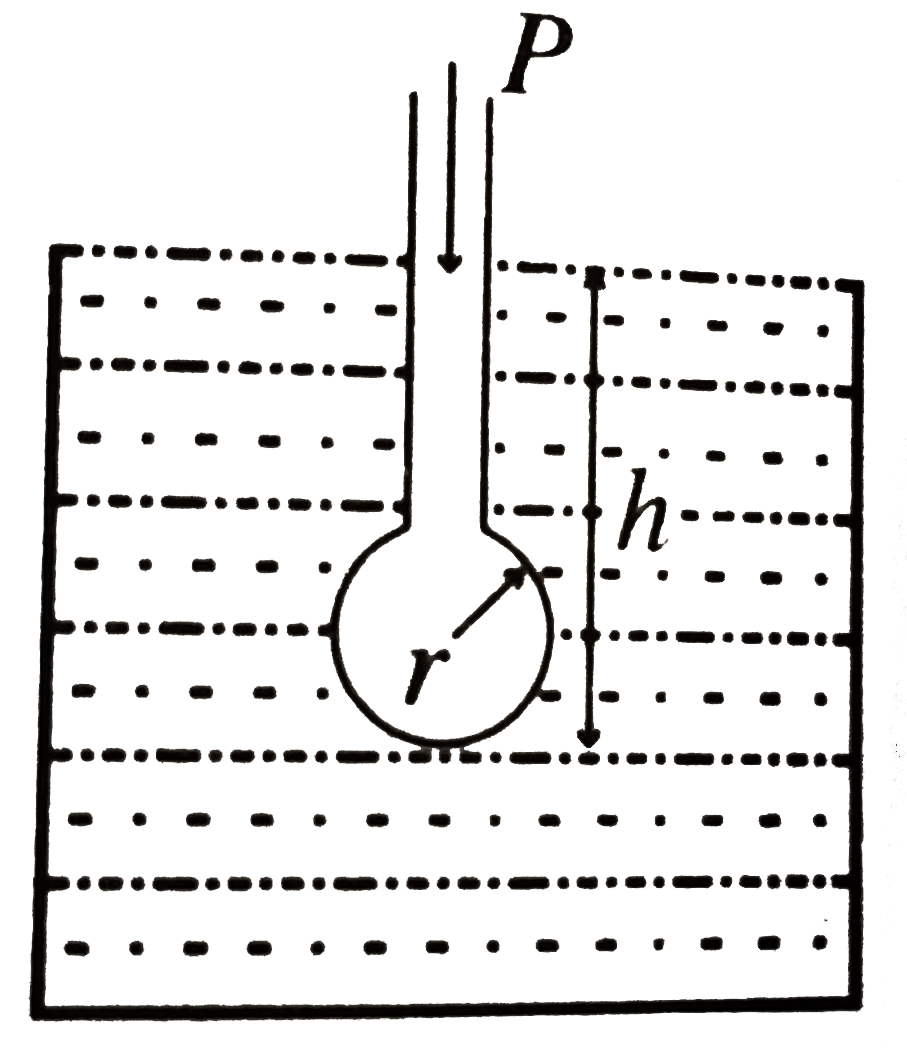A narrow capillary tube is dipped 10cm below water surface and a liquid bubble of radius 2mm formed at the lower end by blowing air through the tube.
a. Calculate the excess pressure due to surface tension.
b. What is the pressure required in the tube in order to blow a hemispherical bubble at its end in water?
The surface tension of water at temperature of the experiment is 7.30×10−2N/m. 1 atmospheric pressure =105Pa, density of water =1000kg/m3
The correct Answer is:1.01146×105
Excess pressure =2T/r=146Pa
Pressure h below the surface ρ0+ρg
∴P=(P0+ρgh)+2T/r
=1×105+103×10×0.1
+2×7.3×10−2103
=1×105+103+146
=1×105+1146
=1.01146×105

Topper's Solved these Questions
- PROPERTIES OF SOLIDS AND FLUIDSBOOK - CENGAGE PHYSICSCHAPTER - PROPERTIES OF SOLIDS AND FLUIDSEXERCISE - Single Correct
112 Videos
- PROPERTIES OF SOLIDS AND FLUIDSBOOK - CENGAGE PHYSICSCHAPTER - PROPERTIES OF SOLIDS AND FLUIDSEXERCISE - Multiple Correct
17 Videos
- PROPERTIES OF SOLIDS AND FLUIDSBOOK - CENGAGE PHYSICSCHAPTER - PROPERTIES OF SOLIDS AND FLUIDSEXERCISE - Exercise 5.3
9 Videos
- NEWTON'S LAWS OF MOTION 2BOOK - CENGAGE PHYSICSCHAPTER - NEWTON'S LAWS OF MOTION 2EXERCISE - Integer type
1 Videos
- RIGID BODY DYNAMICS 1BOOK - CENGAGE PHYSICSCHAPTER - RIGID BODY DYNAMICS 1EXERCISE - Integer
11 Videos
Similar Questions
The lower end of a capillary tube of diameter 2.0 mm is dipped 8.00cm below the surface of water in a beaker. What is the pressure required in the tube in order to blow a hemispherical bubble at its end in water? The surface tension of water at temperature of the experiments is 7.30×10−2Nm−1. 1 atmospheric pressure =1.01×105Pa, density of water =1000kg/m3,g=9.80ms−2. also calculate the excess pressure.
View SolutionThe lower end of a capillary tube of diameter 2.00 mm is dipped 8.00 cm below the surface of water in a beaker. What is the pressure required in the tube in order to blow a hemispherical bubble at its end in water? The surface tension of water at the temperature of the experiments is 7.30×10−2N/m. 1 atmospheric pressure =1.01×105Pa density of water =7000 kg/m3,g=9.80 ms−2. Also calculate the excess pressure.
View Solution
Knowledge Check
The surface tension for pure water in a capillary tube experiment is
Aρg2hrB2hrρgCrρg2hDhrρg2A soap bubble of radius 10−2 m is formed . The surface tension of the soap bubble is 0.04 N/m The excess of pressure inside the bubble is
A160N/m2B16N/m2C1.6N/m2D0.16N/m2At a depth of 5 m below the free surface of a liquid, an air bubble of radius 2 mm is formed. The pressure inside the bubble will be (The surface tension of water is 20×10−8 N/m.)
A2×105N/m2B1.5×105N/m2C3×105N/m2D5×105N/m2
Calculate excess pressure in an air bubble of radius 6 mm. Surface tension of liquid is 0.58 N/m.
View SolutionCalculate the pressure inside a small air bubble of radius 0.2 mm located just below the surface of water. Take,
Surface tension of water =7.2×10−2N/m
Atmospheric pressure =1.01×105N/m2
View SolutionA glass tube of radius r is dipped vertically into a container of mercury of density ρ with its lower end at a depth h below the mercury surface . If S is the surface tension of mercury, what must be the gauge pressure of air in the tube to blow a hemispherical bubble at the lower end?
View SolutionA glass tube of 1mm diameter is dipped vertically into a tube of mercury, with its lower end 3 cmm below the mercury surface. What must be the gauge pressure of air in the tube to blow a hemispherical bubble at its lower and ? Given, density of mercury =13.6g/cc and surface tension of mercury =0.540Nm−1.g=10ms−2.
View SolutionThe excess pressure inside a soap bubble of radius R is (S is the surface tension)
View Solution
